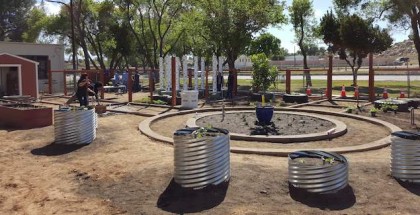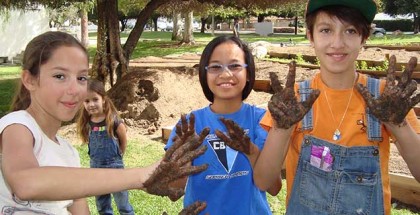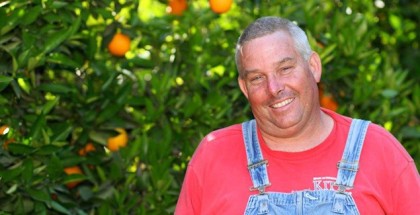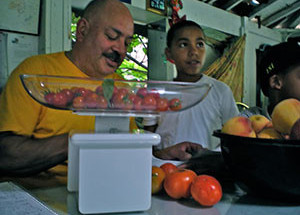Posts By Anne Craig
City of Perris’s Cutting-edge Urban Community Garden to Tackle Growing Problems in Inland Empire
April 11, 2016 | Anne Craig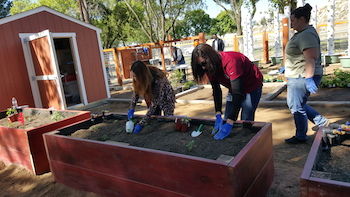
City workers, representatives of partner organizations Riverside County Department of Public Health and the Eastern Municipal Water District and elected officials gathered on March 31 to plant the first seeds at The Perris Green City Farm. Photo courtesy of the City of Perris.
In the City of Perris, CA located in Riverside County, the future of urban farming will soon be on full display. On April 23, the city will host an open house to introduce citizens to the Green City Farm Program, a state-of-the-art urban community garden initiative intended to provide a rich harvest of food, education and community building.
“The direction came from the Perris City Council and the community,” says project manager Isabel Carlos, Assistant Director of Administrative Services for the city. “What’s so cool about the vision is that it’s really a trendsetting urban demonstration project designed to address many of the problems we’re facing here in the Inland Empire. It’s built to facilitate small footprint growing and be extremely water efficient, while producing 50 percent faster growth and a higher yield.”
Techniques being incorporated into the community garden design include vertical and horizontal growing systems: hydroponic towers that employ water to irrigate roots, aeroponic towers that mist plant roots to facilitate growth, aquaponic towers that make use of nutrients from fish to fertilize the plants, as well as traditional raised garden beds. Read More
To Break Cycle of Poverty, Uncommon Local Organization Sees Solution in Urban Agriculture
February 22, 2016 | Anne Craig
Photo courtesy of Uncommon Good.
In 2011, Nancy Mintie, founder of Claremont, CA-based Uncommon Good saw in urban agriculture an opportunity to help fulfill her organization’s mission to break intergenerational poverty cycles and give people the tools to lift themselves up. Mintie says her embrace of urban agriculture in Uncommon Good’s ongoing efforts to promote health, wellness, education and sustainability was a matter of leveraging a resource that had been right under her nose.
The seed was planted during the recession.
“We’d been doing education and social services work, and we saw the level of hardship just skyrocket,” she says. “We were seeing a reverse migration since people were now starving here as badly as they had been back home in Mexico.”
Hope was in short supply.
So Mintie started with the idea that a community garden could, at least, get people fed; but her clients had their doubts. Read More
From Teacher to Farmer: Born and Raised Riversider Revives Family Grove, Profits from Diversification
February 5, 2016 | Anne Craig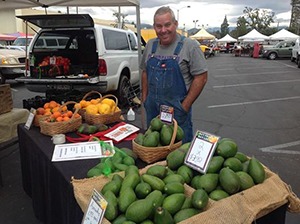
Brian Griffith of Griffith Family Farm in Riverside, CA selling his fruits and vegetables. Image courtesy of Brian Griffith.
When the recession eliminated Brian Griffith’s teaching job of 22 years, he wasn’t sure at first just what he’d do next.
“It was a difficult time,” he says. “That same year, my dad was diagnosed with Alzheimer’s.”
His parents lived on a two-acre property in Riverside, California.
“There was a citrus grove there and they didn’t care for it much or pay much attention to it,” he says. “Navel oranges had been really overplanted in Riverside at one time, and there was almost no money in growing a small quantity of them if you were selling them through the packing houses.”
At loose ends and on unemployment, he decided to try to sell some of the fruit the grove produced at a farmers’ market. Read More
New Data Collection Toolkit Allows Urban Farmers to Measure Progress
January 5, 2016 | Anne CraigUrban farmers and gardeners now have a brand new way to measure their results and gather hard data thanks to the Farming Concrete Data Collection Tool Kit.
The project originated in New York City in 2009 as a collaborative venture between nonprofits Added Value Farms and the Design Trust for Public Space. The data collection tools are intended to help individual farmers quantify what they are doing in ways that will help them both improve and promote their farms. Read More
From 20 to over 220 Schools, California Thursdays Farm-to-school Program Growing Fast
December 29, 2015 | Anne Craig
Farmer Bob Knight of Old Grove Orange in Redlands, CA., lunching with some satisfied customers.
Photo courtesy of San Diego Unified School District
It started small, with 20 elementary schools eating fresh local lunch every Thursday. Now, San Diego Unified School District’s farm-to-school menus are being served up at over 220 schools in the district to 132,000 kids. The ultimate goal is to have all 26 million meals a year be fresh, local and made from scratch, and district officials believe it can be done.
“We were able to grow the program rapidly,” says Tara McNamara, marketing coordinator for the district’s Food and Nutrition Services department. “We started last October at 20 elementary schools, and that expanded to 60 by the end of last school year. Now we’ve got 225 at the beginning of this year.” Read More

